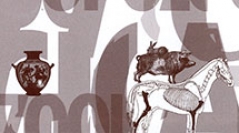

 Anthropozoologica
46 (2) - Pages 63-84
Anthropozoologica
46 (2) - Pages 63-84If a publication revealed the discovery of a lion’s skeleton at Saqqara (Callou et al. 2004), it was not possible to publish all the information. This article aims at filling this gap and discusses the results in the light of new evidence. The skeleton discovered at the second level of the Maia’s tomb, Princess Meritaten, sister of the king Tutankhamun (Zivie 2009), belongs to a male adult who is at least 9 years old. Several indications support the idea that the body had been mummified. In the absence of radiometric dating, the stratigraphic position assigns the deposit of this large mummy (approx. 1.50 m) to the Ptolemaic and Roman periods. The animal lived many years in captivity, in poor conditions, particularly in terms of food. Indeed, there are no teeth in good preservation on the jaws; teeth are fractured and present signs of chronic and old inflammation. Fractures on the right ribs and on some thoracic vertebrae show also that the animal has suffered at least one fall. This skeleton of a lion, animal whose geographic origin is unknown, is the first to be whole discovered in Egypt.
Egypt, Lion, Panthera leo, Antiquity, mummy, dental pathology.